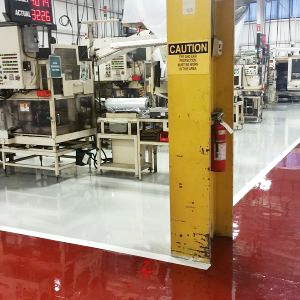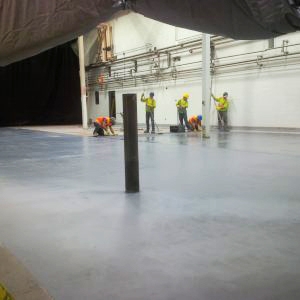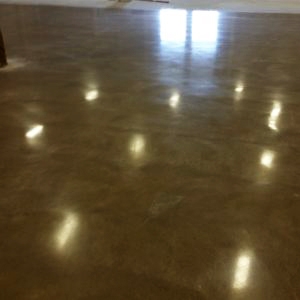Epoxy Flooring
Epoxy flooring products are applied over concrete floors to provide a durable, safe, and attractive floor. Epoxy is mainly installed in the industrial sectors.
Concrete floors can be strong and long lasting. However, the surface or wear layer is usually the weakest part of the concrete. The near-surface wear layer receives most of the wear and abuse that comes with an active facility. Concrete is a porous material and will absorb oil and chemicals that penetrate deep into the concrete, and sometimes the substrate. This will result in contamination of the substrate and/or will cause the concrete to prematurely deteriorate. This is why an epoxy coating can be the perfect solution.
Some benefits of epoxy coatings are:
- systems can have anti-skid texture added in wet areas
- custom colour matching available
- increases abrasion and chemical resistant vs. concrete
- smooth coatings are easily cleaned and maintained
- fast curing for quick turnaround
¼ Inch Epoxy Trowel Down Flooring
Epoxy trowel-downs are typically 1/4″ thick troweled floor systems for heavy duty or extreme environments. This system will give the durability of an epoxy coating on the surface but increase impact resistance.
¼ inch epoxy trowel down is a great option when the concrete is old or badly damaged. An overlay will provide a new workable surface that is stronger than the original concrete. Epoxy mortars have the ability to be installed in a short turnaround time and will provide seamless/monolithic flooring.
Safety Lines, Walkways, and Line Hatching
Using a standardized colour scheme for designated areas throughout a facility is a great asset to any facility safety program. With epoxy resins, Abate and Associates can help you design and install custom safety lines throughout your facility. Areas can be identified to allow forklift or pedestrian traffic using a colour code scheme that can be educated to the workforce through your safety programs.
Battery Storage
Battery storage areas must be contained or guarded against high concentrations of sulphuric acid and abrasion. Using specialized material and aggregates Abate and Associates can install a solution to this sensitive area in your facility.
Containment provides the following:
- decreases the loss of chemicals
- increases the protection to concrete substrate and ground water
- reduces the cost of chemical attack to the concrete
- creates a safer environment for your employees
- reduces the risk of fines and penalties relating to spills and breaches
Concrete Polishing
Diamond polishing for concrete is a green, cost effective, and aesthetically pleasing solution. Polishing is suitable for refurbishing old concrete flooring or producing new durable, low-maintenance, high gloss installations.
Using metal bonded diamonds and resin bonded diamonds, concrete can become a beautiful finish to new and existing concrete floors. Operating planetary grinders, Abate and Associates will use the metal bonded diamonds to remove the “cream layer” to expose a small or large amount of aggregate (depending on the desired finished of the client).
Once Abate and Associates has opened the surface and honed the concrete with multiple metal bonded diamonds grits, we will begin the polishing process with resin bonded diamonds. After multiple steps with the resin bonded diamonds the concrete will have a concrete densifier applied and we will then continue to polish with additional resin bonded diamonds. Once we complete the steps to achieve the desired shine of the client, Abate and Associates will apply a polished concrete guard to protect the surface even further.
Concrete staining is an option during the concrete polishing process. Using water based stains, Abate and Associates can change the tone/colour of the concrete leaving a nice semi-transparent look. Professionals will have their opinions as to what stain works best (acid or water-base) but, ultimately it is the installer that must take into account the scope of work, environment and the service of the floor. This consideration will help in the selection of what kind of stain to use.




